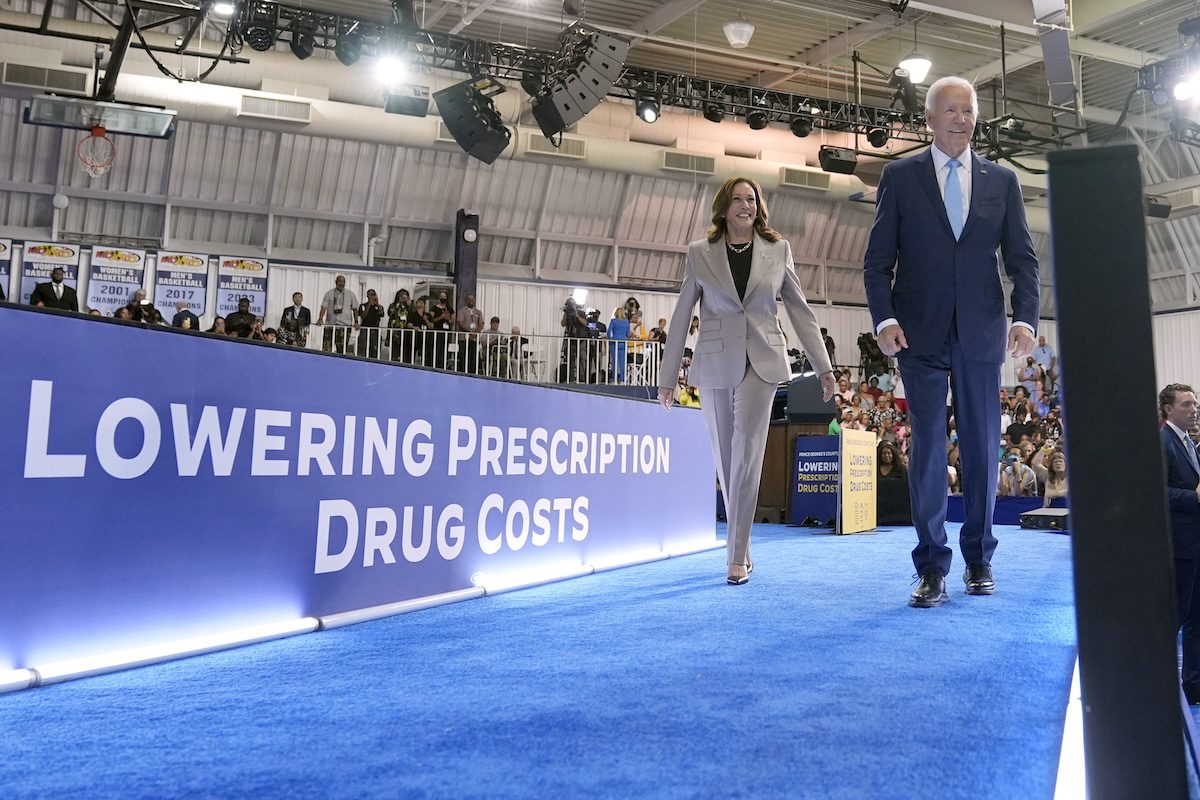
Democratic presidential nominee Vice President Kamala Harris, left, and President Joe Biden depart after speaking about the administration's efforts to lower prescription drug costs during an event at Prince George's Community College in Largo, Md., Thursday, Aug. 15, 2024. (AP Photo/Susan Walsh)
The Inflation Reduction Act ensured that 63,000 Virginians were able to keep their health insurance, reduced the cost of insulin for over 36,000 Virginia seniors, and incentivized manufacturers to invest in the state and create more clean energy jobs.
Two years ago today, the Inflation Reduction Act (IRA) was signed into law.
The legislation represented the largest-ever investment in fighting climate change, lowered health care and prescription drug costs, raised taxes on corporations, and boosted funding for the Internal Revenue Service to go after wealthy tax cheats.
The bill was passed with only Democratic votes—including Virginia Sens. Tim Kaine and Mark Warner, and every Virginia Democrat in the House. Every Virginia Republican in Congress voted against the bill, despite its potentially transformative impact on the economy and the nation’s clean energy infrastructure.
Here are some highlights of how the Inflation Reduction Act has impacted Virginia:
Lower health care and prescription drug costs
The Inflation Reduction Act extended generous subsidies that helped make Affordable Care Act (ACA) health insurance plans more affordable for working- and middle-class families.
Those subsidies were introduced as part of President Joe Biden’s American Rescue Plan of 2021, and were set to expire at the end of 2022, but the IRA extended them through the end of 2025.
Roughly 63,000 Virginians were set to lose their individual coverage and become uninsured had those subsidies expired at the end of 2022, but thanks to the Inflation Reduction Act, those people got to keep their insurance.
The IRA also reformed Medicare to lower drug costs for many of the roughly 1.1 million Virginia seniors with Medicare Part D coverage, which covers prescription drugs.
For example, beginning last year, all vaccines covered under Medicare Part D are free, and the bill implemented a $35 monthly cap on insulin for Medicare recipients.
As a result, 36,461 Virginia seniors on Medicare who use insulin are now charged no more than $35 per month for an insulin prescription.
The IRA will also implement a $2,000 cap on Medicare recipients’ annual out-of-pocket prescription drug costs, beginning in 2025. In Virginia, an estimated 390,400 seniors are expected to save $441 a year each due to this provision, according to an analysis by the US Department of Health and Human Services.
Additionally, the law authorized Medicare to negotiate prices for expensive drugs with pharmaceutical companies for the first time. On Thursday, the Biden-Harris administration announced the new, lower prices of 10 expensive and widely-used drugs that were selected last year for the first round of negotiations.
The negotiations — which used the power of Medicare to lower drug costs for seniors — are expected to save taxpayers about $6 billion in 2026, when they go into effect. The new prices will be anywhere from 38% to 79% lower than the drugs’ list prices last year, saving seniors on Medicare an estimated $1.5 billion in out-of-pocket costs in 2026 alone.
Fighting climate change and saving families money on energy
Arguably the most critical element of the IRA is its provisions to reduce emissions that cause climate change and drive extreme weather events. The law aims to do this by establishing a mix of tax credits for companies and rebates for consumers in order to make the manufacturing and consumption of clean energy technologies and products cheaper.
In other words: by making clean energy—like solar, wind, and hydropower—cheaper to produce and use, the IRA seeks to hasten the transition away from fossil fuels that are one of the biggest sources of emissions.
For example, under the law, manufacturers get subsidies for building electric vehicles (EVs) and renewable energy products, and utilities get credits for choosing solar and wind energy over fossil fuel plants.
In Virginia, several manufacturers have already taken advantage of the IRA’s incentives.
For example, Swedish-Swiss corporation ABB invested $6 million into a new 65,000-square-foot manufacturing, testing, and repair facility in Mechanicsville. According to the company, the facility will employ nearly 100 skilled production workers when at scale.
ABB’s motion traction division creates a range of electrified equipment, such as converters and batteries for the railway transportation industries. The division also creates electric off-road construction machinery for mining and electrical buses. Once fully operational, workers will be tasked with building smaller pieces of equipment and assembling them into larger components that are installed into the machinery.
The IRA also provided $80 billion in financial rebates for millions of households to adopt those clean energy products, such as electric vehicles, solar panels, and more efficient heat pumps.
More than three million American households took advantage of the IRA’s subsidies for homeowners last year, which led to a combined savings of $8 billion, according to data from the Treasury Department. This includes 89,850 Virginia households that saved over $221 million, or $2,243 per household on average.

‘Ideas are not illegal’: Arlington academic fights back against Trump administration’s deportation efforts
The ACLU of Virginia alleges that Suri, an Indian citizen who was studying at Georgetown on a J-1 visa, was targeted because he and his wife...

Trump pushes to end union rights for many federal workers
Hundreds of thousands of federal workers live or work in Virginia. President Donald Trump continued his attack on federal workers on Thursday with...

Senator Mark Warner says Hegseth should resign over group chat leak
“If the level of this information had gotten out, and it hadn't been a responsible journalist, but it was somebody that could have turned this over...

Masked officials detain Rosslyn man for deportation despite no charges
“Trump has made no effort to disguise the fact that the arrests of academics like (Badar Khan) Suri and Mahmoud Khalil is intended to have a...

How another Trump trade war could hurt Virginia
In 2024, Virginia imported $41 billion worth of goods and exported $22 billion worth of goods, according to data provided to The Dogwood by the...

Virginia House forms emergency committee over Musk’s attacks on federal workers
“This is not about politics—it’s about protecting Virginia’s workforce, economy, and essential services," Virginia House Speaker Don Scott said. A...




